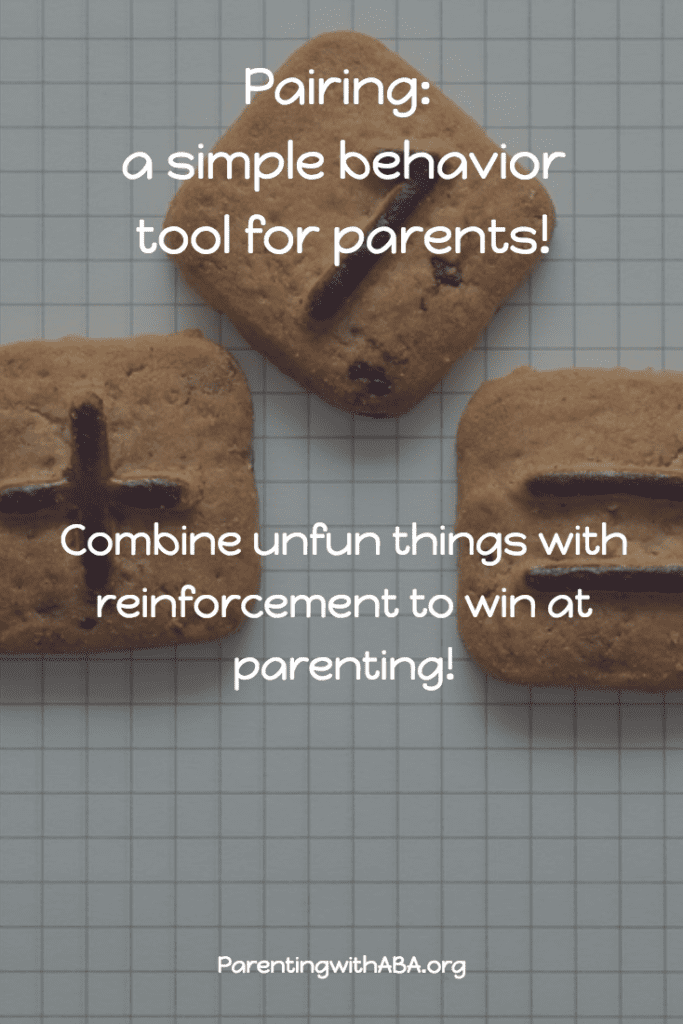
When working in schools as a special education teacher, I heard a lot about ‘pairing’ when you first start working with a child. This meant to pair myself with reinforcement so the student would find me reinforcing (and not hate my guts as their new teacher).
Hopefully as a mom, you yourself are already reinforcing to your child and you don’t have to try to make your presence in their life reinforcing to them. I mean- we do meet their every need. All day long. Every day. 24/7. EVERY need.
Anyway- the idea of ‘pairing’ can be useful to us Moms of Littles when we think about everyday activities that must happen but are not always super reinforcing to our children. We are trying to transfer the reinforcing properties of the fun thing to whatever is less desirable to your kiddos.
What things do your kids avoid, protest, make a living nightmare for you? Getting dressed, eating vegetables, taking turns, etc? If we try to pair these things with something reinforcing, then we can decrease problem behaviors that happen during everyday routines.
Example 1: Your kid hates putting on their shoes, but loves singing songs. Reserve the favorite songs for when you are putting on their shoes. I know you are dying to sing (insert most annoying kid song title here), but don’t do it except when it’s time to put on shoes.
Your response: that will never work!
Me: Oh just try it. Research shows that combining a less preferred activity with a highly preferred activity can decrease problem behaviors. It can increase the likelihood of your child engaging in the less preferred activity without protest.
Me: What have you got to lose?
Example 2: You want your child to engage in conversation with you, but they don’t really like talking. Well, talk about their preferred items/ activities while DOING their preferred items/ activities. Watch ‘Frozen’ together. Again. But actually watch it this time and talk about what is going on in the movie. Maybe even hit the pause button and chat for a minute. That quiet kid may be ready to open up all about Princess Elsa (Or whomever. I have an infant. I have successfully avoided watching this movie. So far.)
Example 3: Your kid hates eating vegetables but loves being outside. Why not have dinner on the patio? Oh yeah, snow. Well, when the weather is warmer, eat those veggies outside!
Example 4: Shall I go on?
A real example from my life: my little E was having a hard time taking a bottle a) at bedtime and b) from someone other than me. We paired the bedtime bottle with a few minutes of watching ‘The Wiggles’. Now she lets her dad feed her before bed regularly and I don’t worry about her going to bed with an empty stomach and waking me up in the middle of the night or super early because she is hungry. It’s a win-win. Plus, my husband now does a mean rendition of the song ‘Fruit Salad’. What’s not to be happy about?
Pair a less desirable activity with something you know your kid likes. Stick with it until the less desirable activity is no longer an issue in your home.
Big picture- fade out the highly preferred activity over time. You don’t have to keep pairing these things forever. When it feels like you are having success regularly, then start fading out. Don’t just drop it all at once. Slow and steady wins the race.
RESEARCH is cool!
Hanley, G., Iwata, B., Roscoe, E., Thompson, R., & Lindberg, J. (2003). Response Restriction Analysis: II. Alteration of activity preferences.JABA, 36(1), 59-76.
Cooper, J., Heron, T., & Heward, W. (2007). Basic Concepts. In Applied Behavior Analysis(2nd ed., pp. 40-41). Columbus: Pearson.
Interested in learning some more behavior strategies for moms? Parenting with Science: Behavior Analysis Saves Mom’s Sanity is available now!
Recent Comments